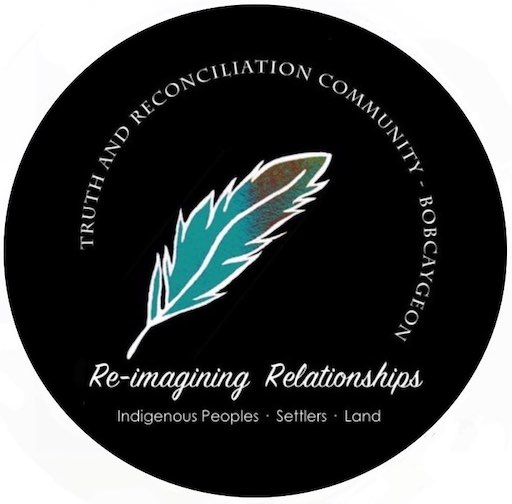Gdinuhwendimin / Beach Park
Gdinuhwendimin:
“We are all related”
This native species garden and gathering space located at the Bobcaygeon Beach Park has been a work in progress since autumn 2020 when significant changes to the park were first proposed. Curve Lake Elder Gidigaa Migizi (Doug Williams) often shared stories of coming to this place as a child with his grandmother to sell baskets, camp, fish and more. This was the seed of the idea to create a space to publicly acknowledge and honour the Indigenous relationships and histories of these lands and waters. At the suggestion of the Curve Lake Cultural Centre, TRC Bobcaygeon began to collaborate with Beedahbin Peltier (https://indigenize.ca/aboutus/) to learn about and select native species for the garden and to endeavour to create this space in a respectful and relational way.
As with all important relationships, the Gdinuhwendimin garden and space has taken time to grow. In May 2024, with the help of students from the Bobcaygeon Public School plants found their new home in the garden. This peaceful space and the relations sown here are meant to be visited and cared for. There are stories to share, more relationships to foster.
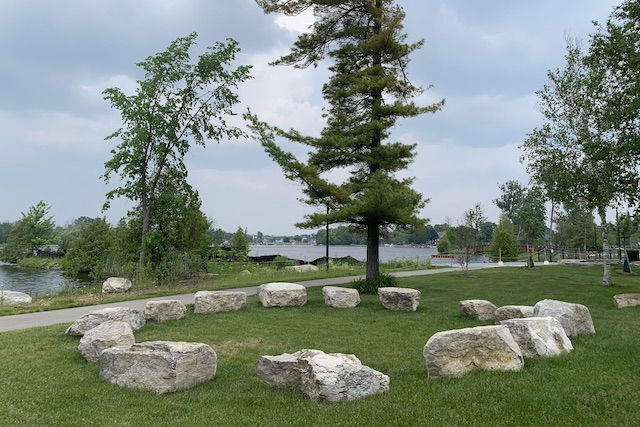
The Vision
This circular garden and meeting place will be an exciting educational addition to the park experience for everyone. It will feature plants native to the region, along with information on how the species is used by First Nations people and the various plant species importance in the Eco system. The garden will also welcome animals and insects that enjoy shoreline environments and thrive on some of these rare native plant species.
The 14 stones were excavated from the Beach Park site during extensive park restorations from 2020-2022 and placed in a circle with an Eastern entrance, where the rising sun enters the space. The gardens will encircle the stones and feature plants like Sweet Flag, Sarsaparilla, Bee Balm, Canadian Anemone, Vervain, Blue Lobelia, Prairie Smoke, Pearly Everlasting, Lady Slipper and many more plants native to this territory.
One might ask, what does a garden have to do with honouring Indigenous relationships and histories and with fostering better relations today among Indigenous peoples, non-Indigenous peoples and the land?
Gdi nuwendimin garden calls us into circle. It calls us to sit together in reflection, in conversations, in stories. The plants remind us of our connection, or possibly our disconnection, with them and this place. How many of these plants do we recognize? … know? Can we speak to and about them and their relationships? Do we know their stories and their teachings? Elder Doug Williams taught that “Nishnaabeg from the mist of time, would say that a garden is more primal than humans themselves … the first garden occurred at the time of creation.” Everything humans need to “live, survive and prosper on this earth” is found in this original garden. Gdi nuwendimin garden aims to be a place to remind us of this.
Anyone who has cared for a garden knows that, like all relationships, gardens need love, care, attention and patience. A sense of curiosity and humour helps, too. What better metaphor for all important relationships. What better metaphor for reconciliation.
Our Name
We would like to express our heartfelt gratitude to Anne Taylor for discerning such a beautiful name for this space.
The Anishinaabemowin name for this place of meeting and gratitude: Gdinuhwendimin translates to “We are related”. This name embodies a fundamental tenet of Anishinaabe culture: the teaching that everything is related: that we are related to the earth, to the water, to the plants and trees, to all other humans and all living beings – the 2 legged, the 4 legged, the winged, the crawlers and the swimmers.
When we also consider the teaching that everything is alive or has a spirit, we are drawn to understand that we have a responsibility to care for each other and for Mother Earth.
Please visit the garden and let us know your thoughts and feelings about the project. We welcome your input. We are delighted that the plants are bedded, are flourishing and bringing new life and new knowledge to the community and its visitors.
The History of
the Beach Park Area
When the City of Kawartha Lakes was developing the Beach Park ,TRC Bobcaygeon was delighted to be able to enter into discussions with CKL about the possibility of a Friendship Garden. This meant that history lessons taught to us by elder Doug Williams and the deeper understanding of the cultural signifigance of this land could be brought forward to enrich the learning of the larger community.
This section of the Beach Park development was at one time a trailer park. The addition of a garden was transformative to the whole area adding beauty and a new sense of place. The garden and all it signifies adds so much to the Beach Park development as a whole.

Start of the project.


In 2023 Doug Kennedy of GreenSide Up Environmental Services prepared the garden beds for this project. City of Kawartha Lakes 2024 50/50 Community Project Capital Fund Program stepped in to help us fund the purchase of some plants so that we did not have to rely solely on seeds that we had harvested.
On a very wet day in May of 2024, Lindsay Wesslink’s intermediate class for Bobcaygeon Public School arrived to help plant the garden. Marc Pandza of Curve Lake First Nation led us in a ceremony and Sherry Telford offered a brief history of this project. The kids were troopers in the rain and were fully engaged in doing a great job.

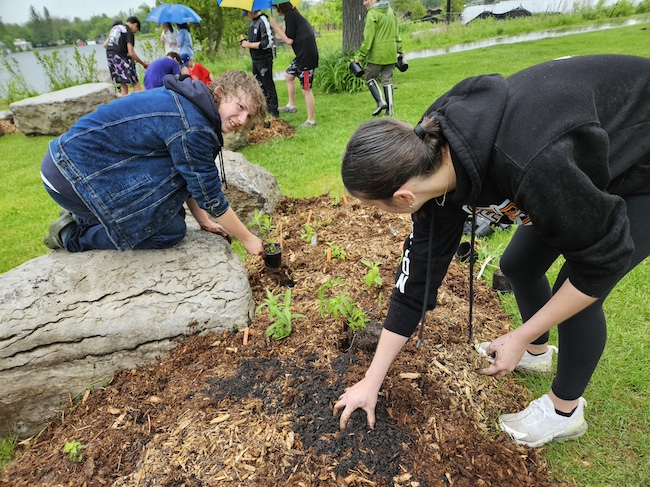

Learning about plants / Collecting seeds
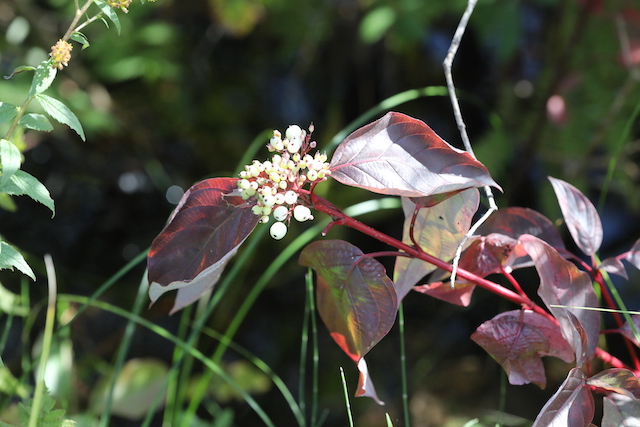

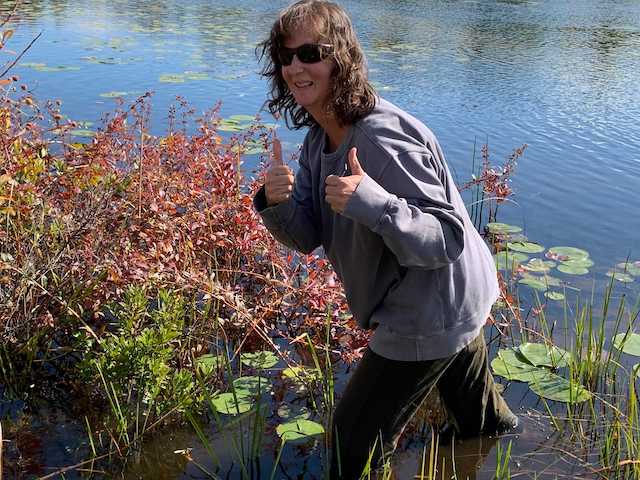
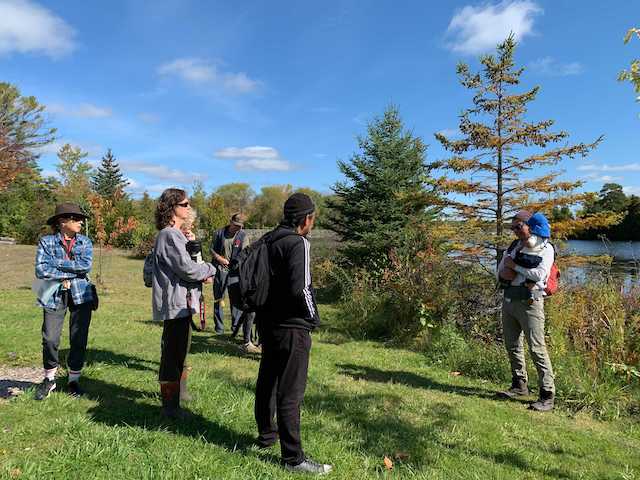
While we were researching what plants to add to the garden, we were fortunate to get out for teachings on the land with Beedahbin Peltier. We were looking at plants that we could harvest for seeds. At every turn Beedahin shared the living aspects of the language (Anishinaabemowin) and how the plants have so much to teach us. Indigenous ways of knowing were woven through the time that we spent together – we learned about the importance of our relationships with all living entities – our relationships to the air, water, plants, animals, our family members and community.
We were introduced to plants that we have seen daily in a new way. Understanding the gifts that they have to offer for healing and improving life was great fun. This body of scientific knowledge is being recognized more and more as having a place right alongside the Western ways of approaching science.
Some of the plants in the garden include…
- Wild Strawberry
- Great Blue Lobelia
- Canada Anemone
- Harebell
- Pearly Everlasting
- Slender-leaved Vervain
- Hoary Vervain
- Blue Vervain
- Sweetgrass
- Spotted Joe Pye Weed
- Bearberry
- Ninebark
- Bee Balm
- Common Boneset
- Prairie Smoke
- Bergamot
- Closed Bottle Lupine
